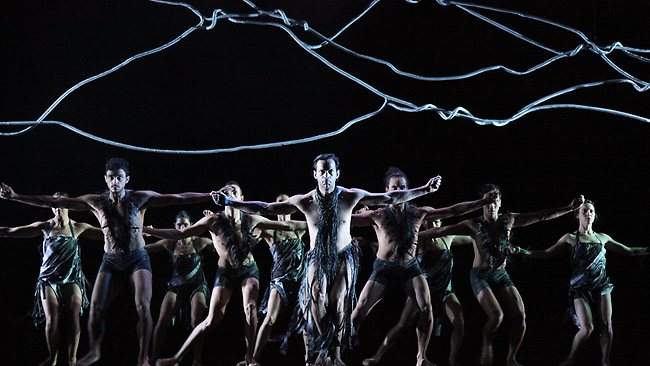Belong
Belong, the newest double-bill from Bangarra, is thematically challenging, technically accomplished, and tendon-achingly transportive. It fuses traditional and contemporary dance styles to investigate the concept of identity as it applies to contemporary Indigenous Australians. The premise of Belong is that to make sense of the enduring present, people must connect with the problematic past. Belong explores the energy and creative fluidity of Indigenous mythologies through movement, music and lighting; it asks innately compelling questions about social identity and cultural authenticity. The cut-out costumes, the set design and the dramatic lighting all enhance the capacity of the dancers to give physical expression to the ghosts of the past. Our ever-present search for identity is explored both within and across generations. The dancers of Belong literally embody that exhilarating sense of connection and emotional frustration which we collectively feel when identifying with a culture, community or country.
Overview
Bangarra Dance Theatre embraces the Indigenous narration of modern-day Australia, and explores the construction of cultural identity through form-fusing choreography. With studios based in the arts precinct at Walsh Bay in Sydney, its productions have sold out across the States and Europe.
Belong, the newest double-bill from Bangarra, is thematically challenging, technically accomplished, and tendon-achingly transportive. It fuses traditional and contemporary dance styles to investigate the concept of identity as it applies to contemporary Indigenous Australians. The premise of Belong is that to make sense of the enduring present, people must connect with the problematic past. Belong explores the energy and creative fluidity of Indigenous mythologies through movement, music and lighting; it asks innately compelling questions about social identity and cultural authenticity.
Comprised of two separate sections, Belong begins with Elma Kris' new work, 'About', her second work for Bangarra. Kris' choreographic development since "Emeret Lu" as part of True Stories in 2007 is apparent in her deft and confident exploration of the connection between Indigenous communities and their physical environment. The opening segment, featuring Kris herself dancing the part of the Storyteller, is visually and thematically arresting; a reformation of contemporary island dance movements which delves into the legends and lore of the Torres Strait wind spirits. It deals with the ways in which totems and kinship interact with the art of story-telling, and whirls the audience through the movements of the wind, sky and sea.
'ID' asks tougher questions about just what it takes to achieve a sense of belonging. Choreographed by Stephen Page, who is an active mentor of creative artists and the Artistic Director of Bangarra, 'ID' is more of a psychological exploration than a mythological one. Painful rites of passage, like posing for school portraits, provide vehicles for Page to highlight how debate over degrees of Aboriginality based on skin colour have created internal division in Indigenous communities.
The cut-out costumes, the set design and the dramatic lighting all enhance the capacity of the dancers to give physical expression to the ghosts of the past. Our ever-present search for identity is explored both within and across generations. The dancers of Belong literally embody that exhilarating sense of connection and emotional frustration which we collectively feel when identifying with a culture, community or country.







